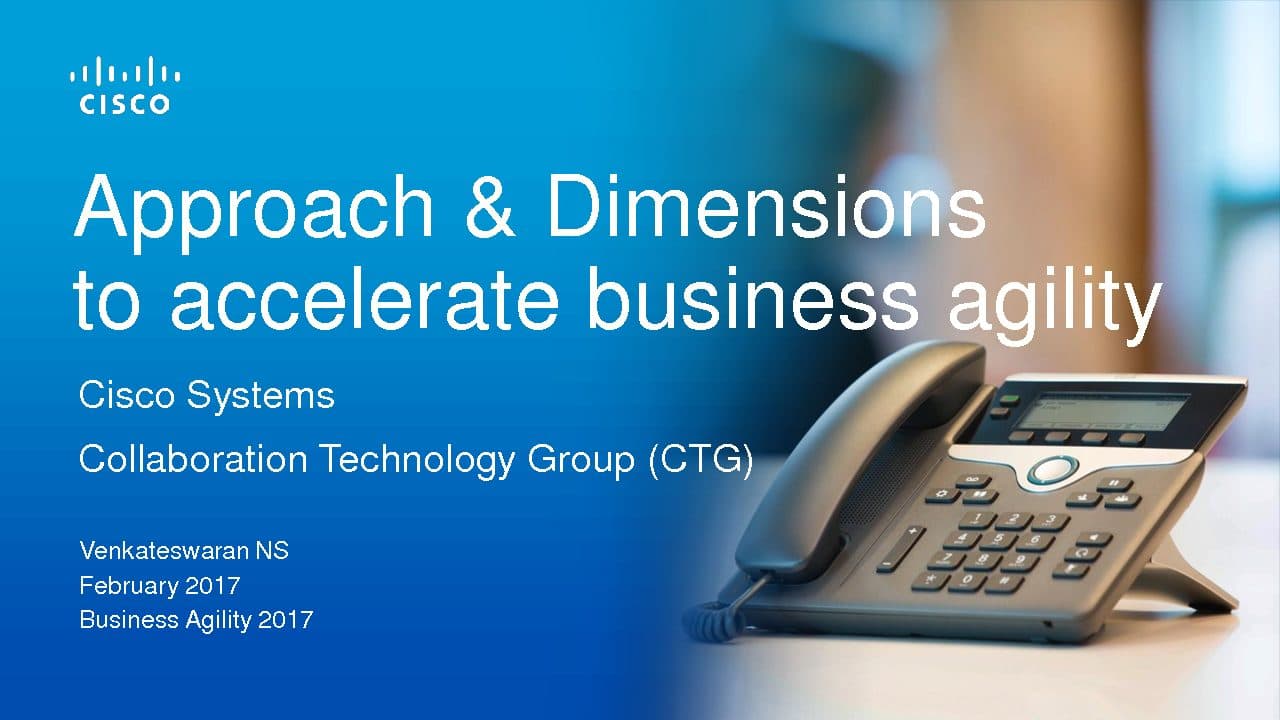Thanks, Charlie. Good morning. I’d like to spend the next few minutes sharing my experiences on different dimensions and approaches within an enterprise to accelerate business agility. Today, I’m going to discuss the Collaboration Technology Group within Cisco Systems.
As you know, Cisco Systems is involved in several businesses. Our group focuses on developing products that facilitate enterprise collaboration—whether in conference rooms, at desks, or on mobile devices. Here’s a quick snapshot of our business: we hold a strong market share, have a significant number of deployed devices, and support approximately 4 billion minutes of WebEx usage per month.
The Need for Business Agility
With such a strong business, why am I talking about business agility? The competitive landscape is evolving rapidly. Traditionally, Cisco’s collaboration competitors were companies like Alcatel-Lucent, Juniper Networks, and Huawei. However, in recent years, we’ve seen a shift—our new competitors are companies like Microsoft, an operating system company, and Amazon, a retail company. This disruption is happening across industries.
No matter what business you’re in, you must assess both traditional and non-traditional competitors. Their pace of change is accelerating. Without the right business strategy and the ability to act quickly, even well-established enterprises risk obsolescence. Many organizations have failed due to a lack of foresight. To navigate this, I categorize enterprise agility into three dimensions: business agility, organizational agility, and team agility. If we can define these dimensions clearly, we can determine whether to drive change from the top-down or bottom-up.
Business Agility
As several speakers have already mentioned, values and culture are critical for organizations. Most corporations have these in place, but the key question is: are they being reviewed periodically? Many enterprises become complacent. There’s a mindset where the customer revolves around the firm instead of the firm revolving around the customer. Are we observing these behaviors and trends within our organizations?
Every function—engineering, marketing, sales, HR, and support—should reassess its values and behaviors. Are these behaviors still relevant? Should we continue them or initiate change? Organizations must take a holistic view of their values and behaviors to create a strong culture.
Leadership and Transparency
Theory is one thing, but action is what matters. Leaders must embody values like transparency. For example, enterprise-wide visibility into business goals is crucial. Does your workforce understand what the company is focusing on for the next quarter? Do they understand why? Is the purpose clearly communicated through the value chain?
Are leaders ensuring employees know what actions to take? Transparency isn’t just about sharing data—it’s about aligning the workforce with strategic priorities.
Eliminating Waste and Optimizing Resources
Legacy enterprises often maintain portfolios that were deployed years ago. Due to licensing models and product lifecycle requirements, they continue enhancing outdated products simply to prove they are still active. But is that necessary? Are customers truly missing the features being added?
By questioning this, organizations may find that certain products require no further development. Eliminating unnecessary work frees up resources and capacity for innovation. Since budgets for hiring are often limited, enterprises must optimize existing talent by identifying and removing waste. Reviewing commercial clauses like licensing models, end-of-life policies, and portfolio-level constraints helps achieve this.
At Cisco, we applied these techniques to free up capacity across global sites, allowing us to focus on innovation. We leverage hackathons and innovation games—both internally and externally—to generate valuable ideas for sustaining disruption.
Collaboration Across Leadership
Leadership collaboration is essential. Often, leaders see teamwork as something relevant only to development teams, dismissing its relevance at the leadership level due to hierarchical status. This mindset must change. Leaders must work together to create a shared vision that extends across all functions—engineering, marketing, sales, and beyond.
The ultimate question is: are we enabling rapid business decision-making? Business agility must result in faster, more effective decision-making across the organization.
Organizational Agility
People are at the core of organizational agility. An enterprise is nothing without its people. Whether working in a single site or across multiple locations, co-located teams must be structured effectively.
Redefining Middle Management
In many organizations, leaders have the vision, and engineers drive innovation, but middle management can be an obstacle. Many agile implementations fail because of insecurity at various levels—whether it’s a senior vice president or a junior engineer. Employees must understand their roles clearly.
Rather than fearing job loss, employees should be encouraged to obsolete their roles while securing their jobs by developing new skills. Defining clear job descriptions and identifying additional skills employees can contribute helps create motivation and boost morale. This shift enables a culture of adaptability.
Empowerment
Once employees are motivated and equipped with the right structures, the next step is empowerment. Are employees empowered to make faster decisions? Are they allowed to fail and learn quickly? Do they have the autonomy to execute tasks efficiently?
Team Agility
The key to team agility is empowered, cross-functional teams. When teams have clear goals, strong infrastructure, and the ability to remove obstacles quickly, they can make decisions faster and execute more effectively. Rapid feedback loops drive continuous improvement.
Our Journey at Cisco
This has been a three-and-a-half-year journey within Cisco’s Collaboration business. The way our products have evolved demonstrates how we have transformed our collaboration business to stay ahead in the industry.
We have named this evolution Cisco Spark, and I would like to present a short demo.
Demo
[Video Plays]
Conclusion
Thank you very much.




